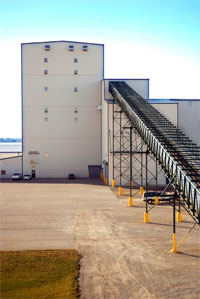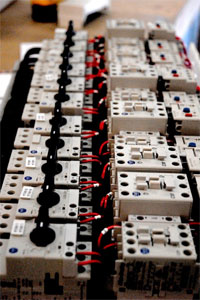Extreme Conditions Call for Extreme Solutions
Grain elevators are facilities at which grains are received, stored, and then distributed for direct use, process manufacturing, or export. Most facilities, however, are home to other operations such as cleaning, drying, and blending. For the most part, these processes have stayed the same for the last 150 years. Of course, better elevators and facilities have been developed and implemented as time has passed, but the basic engineering has stayed the same. In recent decades though, while those same engineering principles have stayed the same, systems and controls changed and evolved as the expansion of computer technology exploded.
As an integrator responsible for many such facilities, ESCO Automation has spent forty years developing solutions to bridge the gap between standard processes and modern network technology. We asked Wes Dautremont, Technical Manager at ESCO Automation, about the hazards associated with creating and deploying a system to help drive facilities developed around grain elevators. “First of all, there are pretty big temperature extremes in the actual floor environment. It goes anywhere from well below freezing to over 120 degrees in the summer months. It is also extremely dusty because of all the grain dust in the air, so it is a bit challenging for a standard PC to live in that type of environment,” said Wes. “It’s also hazardous because there is a lot of moving equipment, open conveyor belts, and even explosion risks if you get a fire started somewhere. That’s why we have to use Class I Div 2 rated clients.”
 These environmental challenges, however, are only part of the issue with creating and deploying systems for facilities such as this. Usually, when dealing with a plant upgrade, integrators must contend with replacing and upgrading computer hardware and IT resources. But at their most recent grain elevator controls upgrade for one of the worlds leading food manufacturers that was not an option. “We were replacing some equipment from the 40’s and 50’s in there. It was some real vintage stuff. The old system didn’t have PLC control or bin gauges. It was just push buttons and relays, which made it difficult to troubleshoot issues and time consuming to track accurate information. They had been using paper and pencil to track product, but didn’t have any method to capture controls or equipment issues,” said Wes.
These environmental challenges, however, are only part of the issue with creating and deploying systems for facilities such as this. Usually, when dealing with a plant upgrade, integrators must contend with replacing and upgrading computer hardware and IT resources. But at their most recent grain elevator controls upgrade for one of the worlds leading food manufacturers that was not an option. “We were replacing some equipment from the 40’s and 50’s in there. It was some real vintage stuff. The old system didn’t have PLC control or bin gauges. It was just push buttons and relays, which made it difficult to troubleshoot issues and time consuming to track accurate information. They had been using paper and pencil to track product, but didn’t have any method to capture controls or equipment issues,” said Wes.
So how do you choose the proper system to replace a system that never existed? After attending the ThinManager Platform 6.0 Launch Event in the spring of 2012, the team at ESCO knew they had found their answer. “We went to the 6.0 Launch Event earlier this year and it was a really good event. I attended the training sessions along with the demo sessions. The hands on demos were really helpful to see what new features had been added. We knew we wanted to get more experience working with ThinManager before completing our first deployment.”
 Wes then explained how ESCO took their new understanding of the ThinManager Platform and created a responsive HMI system for their client. “We set ThinManager up in our test lab and spent a while running simulations to compare it with our attempts at setting up Terminal Services through Windows on our own. The ThinManager Platform makes it much more straight-forward and simple when you need to swap out or add a new client in the field.”
Wes then explained how ESCO took their new understanding of the ThinManager Platform and created a responsive HMI system for their client. “We set ThinManager up in our test lab and spent a while running simulations to compare it with our attempts at setting up Terminal Services through Windows on our own. The ThinManager Platform makes it much more straight-forward and simple when you need to swap out or add a new client in the field.”
Once he had the testing complete, Wes implemented his new system in the facility. “We installed 2 servers and 6 thin clients. The 2 servers are set up with Redundant ThinManager and failover configuration so they can take servers down for cleaning and maintenance and still keep the system running. The plant appreciated the improved robustness of the thin client solution along with the convenience of ThinManager features like client shadowing and ended up replacing 8 more fat clients throughout the plant with thin clients managed by ThinManager. ”
Now that they created and proved the viability of their newly designed system, what’s next for ESCO and ThinManager? “After seeing how much it streamlined the Terminal Services configuration, it has become our go-to recommendation for our customers wanting to pursue a Terminal Services environment,” concluded Wes. “ThinManager allows any plant to move to Terminal Services architecture without having to become an expert in Microsoft Terminal Services.”
